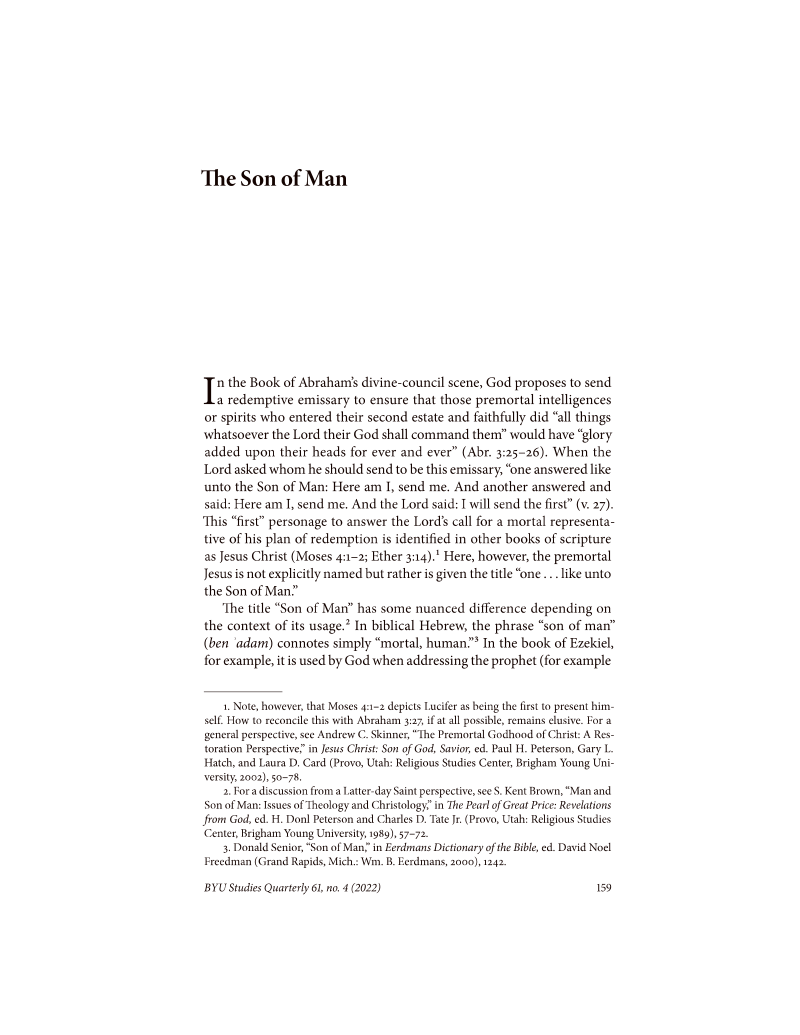Stephen O. Smoot et al. discuss the term "Son of Man" in Latter-day Saint Scriptures and theology.
- Type
- Periodical
- Source
- Stephen O. Smoot LDS
- Hearsay
- DirectSecondary
- Reference
Stephen O. Smoot, John Gee, Kerry Muhlestein, and John S. Thompson, “The Son of Man,” BYU Studies 61, no. 4 (2022): 159-61
- Scribe/Publisher
- BYU Studies
- People
- Kerry Muhlestein, John Gee, Stephen O. Smoot, John S. Thompson
- Audience
- Reading Public
- Transcription
In the Book of Abraham’s divine-council scene, God proposes to send a redemptive emissary to ensure that those premortal intelligences or spirits who entered their second estate and faithfully did “all things whatsoever the Lord their God shall command them” would have “glory added upon their heads for ever and ever” (Abr. 3:25-26). When the Lord asked whom he should send to be this emissary, “one answered like unto the Son of Man: Here am I, send me. And another answered and said: Here am I, send me. And the Lord said: I will send the first” (v. 27). This “first” personage to answer the Lord’s call for a mortal representative of his plan of redemption is identified in other book of scripture as Jesus Christ (Moses 4:1-2; Ether 3:14). Here, however, the premortal Jesus is not explicitly named but rather is given the title “one . . . like unto the Son of Man.”
The title “Son of Man” has some nuanced difference depending on the context of its usage. In biblical Hebrew, the phrase “son of man” (ben adam) connotes simply “mortal man.” In the book of Ezekiel, for example, it is used by God when addressing the prophet (for example Ezek. 2:1, 3, 6, 8; 3:1, 3, 10; 4:1, 16; 5:1; 6:2). In apocalyptic biblical works, most notably the book of Daniel (7;13-14), the Son of Man (Aramaic bar ‘enash) or, more technically, a figure like (kē) a son of man, is depicted as a sort of eschatological figure who assumes rulership over the earth at the end of days. “The figure in this passage [Dan. 7:13-14] is one like a son of man, meaning a divine figure who looked like a human. He will have authority and will be worshipped by all people. Note also the language tying this figure to the Davidic kingship ideal, that he will be a king whose kingdom will be everlasting.
This divine figure was developed in apocalyptic Jewish works from the time of Jesus (such as the book of 1 Enoch) into “a divine messianic figure” and “a premortal being who was closely associated with God, would have dominion over all earthly kingdoms, would be worshipped by all people, would judge the wicked and overthrow his enemies, would establish an everlasting kingdom, and would be the ‘Messiah.’” Believed by his disciples to be this very eschatological figure, Jesus is identified as the Son of Man throughout the canonical Gospels and other New Testament writings (compare Matt. 27:64; Rev. 1:13).
In Latter-day Saint understanding, the title Son of Man takes on additional significance. One of the Adamic names for God the Father is revealed in Restoration scripture to be “Man of Holiness” (Moses 6:57; 7:35). Apostle James E. Talmage and Bruce R. McConkie have both linked Jesus’s identity as the Son of Man with his divine parentage as the firstborn of this Man of Holiness (compare D&C 78:20; 93:21-22; 95:17). As Elder Talmage taught, “The word of revelation given in this day, makes plan the meaning as to who was the one and only supremely glorified Man, whom Christ knew—God, the Eternal Father, the Father of the spirit of Jesus, and literally, the Father of His body. Therefore the title ‘The Son of Man’ is an appellation of glory, authority and power among all sons of men. The Son of Man is the Only Begotten of the one and only supremely glorified Man at that time.
That the Book of Abraham says Jesus was like unto the Son of Man, rather than being the Son of Man, might reflect the influence of the King James Version of the Bible on Joseph Smith’s translation, since that wording appears in Daniel 7:13 and Revelation 1:13. Alternatively, the comparative may have been used because Daniel 7, Revelation 1, and Abraham 3 are all visions, and the visionary image was like unto the actual Son of Man—that is, a sort of visionary or heavenly facsimile of the real thing.
Whatever the case, the identity of the premortal Jesus as “one like unto the Son of Man” in the Book of Abraham might be understood simultaneously in the contexts discussed above. He is the firstborn of the Man of Holiness, the one who condescended to become a mortal “son of man” (compare 1 Ne. 11:14-36) and the foreordained Messiah.
- Source Link
- https://byustudies.byu.edu/journal/61-4/
- Citations in Mormonr Qnas
The B. H. Roberts Foundation is not owned by, operated by, or affiliated with the Church of Jesus Christ of Latter-day Saints.

